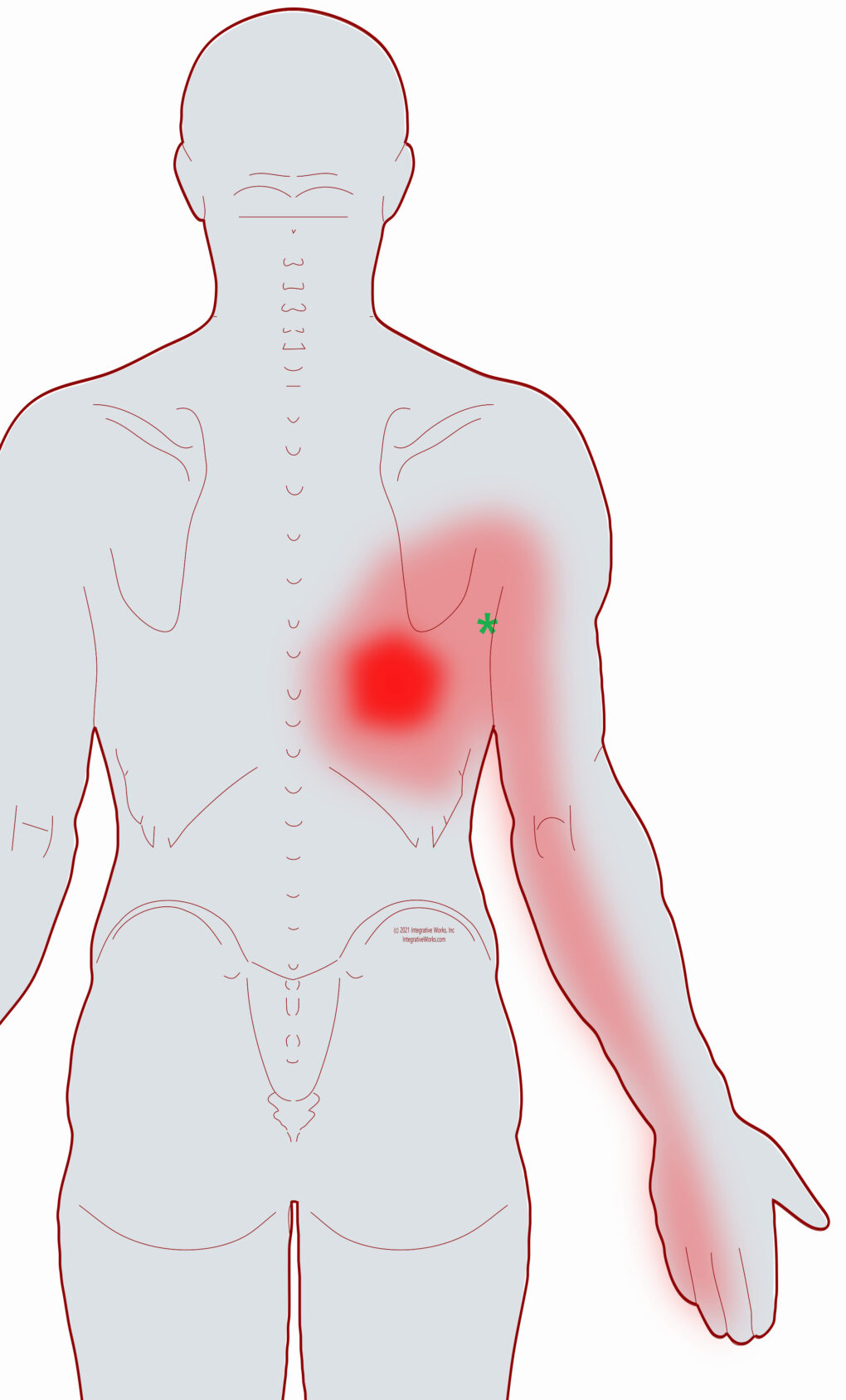Aching mid-back with tired triceps
Table of Contents
- How People Describe This Pain Pattern
- How You Activate and Intensify This Pain Pattern
- Self-Care – Getting Relief on Your Own
- Musculoskeletal Anatomy Behind Your Pain
- Therapy Notes for Massage and Bodywork
How People Describe This Pain Pattern


trigger point referral
People complain of an area of aching pain at the base of the shoulder blade. At times, this extends down the triceps and into the hand. They can’t reach it and may ask to trace the spot on my back or on the illustration that I have on the wall. It has a constant ache that suddenly becomes more painful on certain movements. For example, it can be surprisingly painful if a dog jerks on the leash or if they are using their arm to support their weight as they come down a ladder.
The referral down the arm is not often present. Usually, it flares up when a person is weight training or rowing. Also, it can get achy down the arm during a pulling exercise like raking, weeding, or water skiing.
This referral in the arm makes the triceps ache with fatigue quickly during pullovers, lat pull-downs, or pull-ups and tasks like raking. It seems odd to the person that their triceps ache while doing lat exercises.
Often Overlooked
They often fail to find relief from bodywork. The practitioner often overlooks this muscle which is awkward to treat. As well, the referral down the arm is similar to nerve root pain from C8.
See your Doctor…
The aching in the back creates concern about kidneys or gallbladder as they also refer pain in this area. A medical doctor should check this concern, especially if there are other indications.
How You Activate and Intensify This Pain Pattern
This is usually aggravated by a forward pull that overstretched the upper latissimus dorsi. Ok, you probably aren’t a beefy water ski trickster. It is more likely to be strained by:
- a dog on a leash
- a kid jerking your arm
- jerking while rowing
- raking
- weeding
- trying to unstick a door.
Occasionally this is caused by an upward jerk, but that usually activates other trigger points.
The Musculoskeletal Anatomy Behind Your Pain
Musculoskeletal Anatomy
This broad, flat muscle attaches to almost every bone in the axial skeleton below T6 as well as the pelvis. Read more in this post about latissimus dorsi anatomy.
Getting Relief on Your Own
Pain in this area is also an indicator of problems with your kidney or gallbladder.
See your medical doctor, especially if you’ve had changes in bowel function or urination.
Clinically Proven
Self-Care Strategies
Self-Care Posts have common sections to make them easy to follow and understand:
- Activities to Avoid or Change
- Strategies for Quick Relief
- Stretches and Exercise for Longer-Lasting Relief
- Yoga Corner
Therapy Notes for Massage and Bodywork
Better Bodywork
Through Shared Expertise
Therapy Notes provide details for cranial, spinal, and local joint work. These notes also link to a traditional neuromuscular protocol.
By treating integrative components first, direct work on the muscle becomes less intense while providing longer-lasting relief.
Support Integrative Works to
stay independent
and produce great content.
You can subscribe to our community on Patreon. You will get links to free content and access to exclusive content not seen on this site. In addition, we will be posting anatomy illustrations, treatment notes, and sections from our manuals not found on this site. Thank you so much for being so supportive.
Cranio Cradle Cup
This mug has classic, colorful illustrations of the craniosacral system and vault hold #3. It makes a great gift and conversation piece.
Tony Preston has a practice in Atlanta, Georgia, where he sees clients. He has written materials and instructed classes since the mid-90s. This includes anatomy, trigger points, cranial, and neuromuscular.
Question? Comment? Typo?
integrativeworks@gmail.com
Follow us on Instagram
*This site is undergoing significant changes. We are reformatting and expanding the posts to make them easier to read. The result will also be more accessible and include more patterns with better self-care. Meanwhile, there may be formatting, content presentation, and readability inconsistencies. Until we get older posts updated, please excuse our mess.